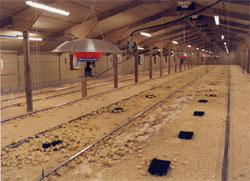



Space-Ray Adds Fuel Savings and Reduces Maintenance for Poultry Houses
GLOBAL - Poultry houses can now save up to 22 litres of propane for each continuous 24-hour period in a house installed with 14 new Direct Spark Ignition (DSI) brooders being introduced by Space-Ray to the worldwide poultry markets, according to a recent study conducted in Europe.


Instead of wasting fuel using a standard pilot light, the new Space-Ray Model SRB40CE No. 5 Direct Spark Ignition Brooder has a powerful spark ignition system that directly lights the main burner. This lowers maintenance since there is no standing pilot to clog up, blow out or waste fuel.
The unique design of the Space-Ray radiant gas brooder allows quick, trouble free access to the main burner orifice by simply sliding back a quick release bracket. This assures longer life, fast and easy maintenance as necessary and lower operating costs.
Stock capacities per burner are 2,000 to 3,000 broilers, 1,500 to 2,000 pullets, 750 to 1,000 turkeys, 750 to 1,000 ducks and 1,500 to 2,000 pheasants.
“If you multiply daily fuel savings by the length of a crop in days and the number of crops per year, our Direct Spark Ignition brooder can save poultry houses a considerable sum of money and add to operational efficiency,” noted Damien Oakley, Managing Director of Space-Ray UK. “A recent fuel study using the new Space-Ray Direct Spark Ignition heaters found that the cost per brooder per day was 84p (US$1.31) or £168.78 (US $263,30) per year less than that of a conventional Pilot brooder. This puts the payback with a Direct Spark Ignition brooder at months compared to the pilot version.”
Broad Heat Pattern Featured
Available in natural or propane gas, the new CE-approved Space-Ray DSI radiant gas brooder has a 12 kW /hr capacity and features a broad heat pattern.
The heat pattern is enhanced by Space-Ray’s unique 60° emitter angle that is especially designed to aim the radiant heat directly at the birds where it is needed most. Space-Ray’s stainless steel emitter is fully insulated and enclosed so that the insulation will not crumble or distort in the tough operating conditions normally found in poultry houses. An engineered spun steel aluminium canopy maximizes the downward heat effect.
The DSI brooder can be used in both single and multi-zone installations. The multi-zone operations can be controlled by thermostats, a computer or an environmental controller. Each brooder incorporates a 100 per cent gas safety shut-off value and a flame failure safety device and is fully CE approved to the latest European standards.
Gas consumption per hour at full heat is a low 1.63 litres/hr for propane and 1.17m3/hr for natural gas.
Brooder mounting heights are recommended from 1,520 to 1,830 mm. Spacing recommended between brooders varies from 7.6 to 12.2 metres. Weight of each brooder is 12 kg. For ease in installation, the brooder consists of factory pre-assembled components.
Radiant Heat Principle Described
Unlike space heaters that work from the top down heating the air and upper areas of the poultry house first before stratifying down to heat the birds, the Space-Ray radiant gas brooders operate using the same principles as the sun’s rays. Radiant warmth is delivered directly to the brooding area where it is needed most, passing heat directly to the litter area and the birds themselves before heating the air. This accomplishes two things. First, the radiant heat helps dry out the litter by keeping ammonia levels lower and the heated floor acts as a thermal reservoir trapping and recycling heat to save energy.
“With this brooder, chicks can select their own rearing environment due to the broad, heat pattern product by our large radiant emitter which aims heat directly at the chicks,” noted Oakley. “This is often not the case with space heaters or pancake type brooding systems. In fact, based on a recent fuel study our radiant gas brooders have proven to provide more reliable and efficient heating at less cost using less units.”
Designers of the original radiant gas brooder in 1958, Space-Ray radiant gas brooders have stood the test of time. Space-Ray brooders come with a full three-year limited warranty on the entire radiant heat emitter assembly and a one-year limited warranty on all other components.
Besides its new DSI radiant brooder, Space-Ray offers a zone brooder, a pilot light brooder, a space heater and a complete line of tube-type gas heaters for poultry applications.








